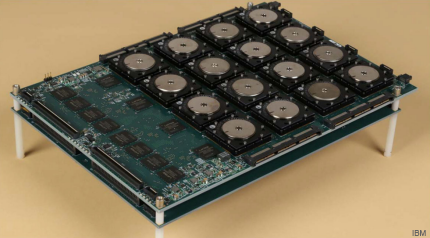5 billion-transistor chip functions like a human brain
IBM’s chip, funded by DARPA, uses its “neurons” and “synapses” to spread computing processes out, performing complex tasks with a very low power requirement.

Sixteen SyNAPSE chips arrayed on a circuit board.
IBM researchers funded by the Defense Advanced Research Projects Agency have developed a computer chip with more than 5 billion transistors and mimics the functions of the human brain. Perhaps most significantly, the chip has extremely low power requirements, making it suitable for unmanned vehicles, ground robots and sensors that operate in remote areas where the availability of power is limited.
The chip, created for DARPA’s Systems of Neuromorphic Adaptive Plastic Scalable Electronics (SyNAPSE) program, is designed to perform functions such as pattern recognition, audio processing and motion control without drawing much power. Tradition computing architectures require a lot of power for those functions, but each SyNAPSE chip requires only 100 milliwatts. In pattern recognition tests, it showed energy savings of two orders of magnitude over current ship technology, DARPA said in a release.
The inspiration for the chip came from the human brain and how biological systems perform complex functions while consuming far less energy than computers. The 5.4 billion-transistor chip, built on Samsung Foundry’s 28-nanometer process, has 1 million “neurons” and 256 million “synapses.” It distributes data and computations cross the chip and, like the brain, processes and transmits data only as required, which saves on power, DARPA said.
It’s still a long way from the processing power of the brain—which contains an estimated 100 trillion synapses or more for the average adult—but it can be tiled into large arrays.
“Computer chip design is driven by a desire to achieve the highest performance at the lowest cost,” said DARPA program manager Gill Pratt. By mimicking nature, and spreading the computing process sparsely across many components to reduce the movement of data, the researchers are able to gain a lot of power efficiency.
“IBM’s chip, which is by far the largest one yet made that exploits these ideas, could give unmanned aircraft or robotic ground systems with limited power budgets a more refined perception of the environment, distinguishing threats more accurately and reducing the burden on system operators,” Pratt said. That kind of efficiency could cut the weight of the batteries soldiers have to take into the field to power radio, mobile devices and other equipment. It also could reduce the battery requirements for unmanned aircraft, or allow them to fly longer—and “see” better—with the batteries they have.
The SyNAPSE program isn’t the only effort to model computing after the brain. But others, like IBM’s Watson, Sandia National Laboratory’s neuro-based system, and the Air Force Research Lab’s neuromorphic computing system, involved supercomputers. IBM and DARPA's project, while involving aspects of supercomputing, is taking that approach down to the chip scale, and taking another step toward cognitive computing.
In fact, another thing the SyNAPSE chip would be good for, researchers said, is studying the brain itself through neuroscience modeling. Linking multiple chips together could allow them to develop large-scale neuromorphic simulators that could allow them to better understand how the brain works.
NEXT STORY: DARPA explores next-generation imaging radar